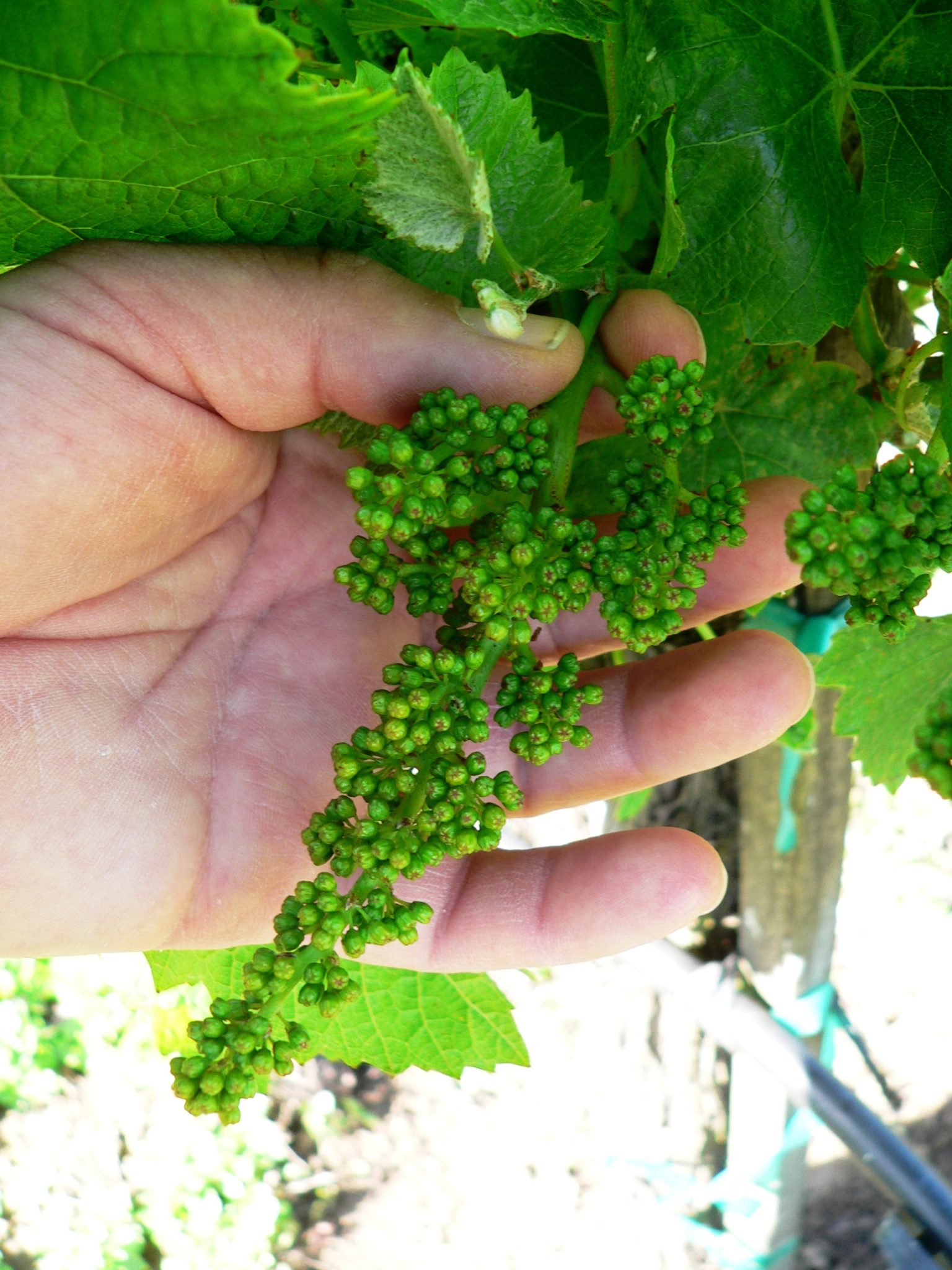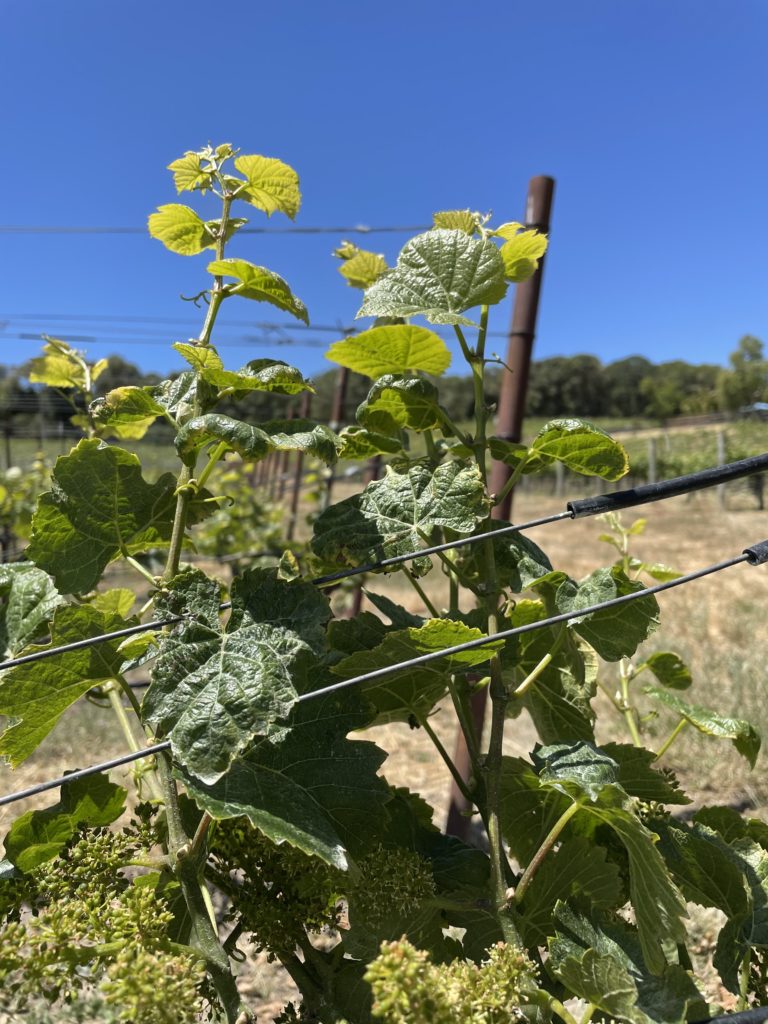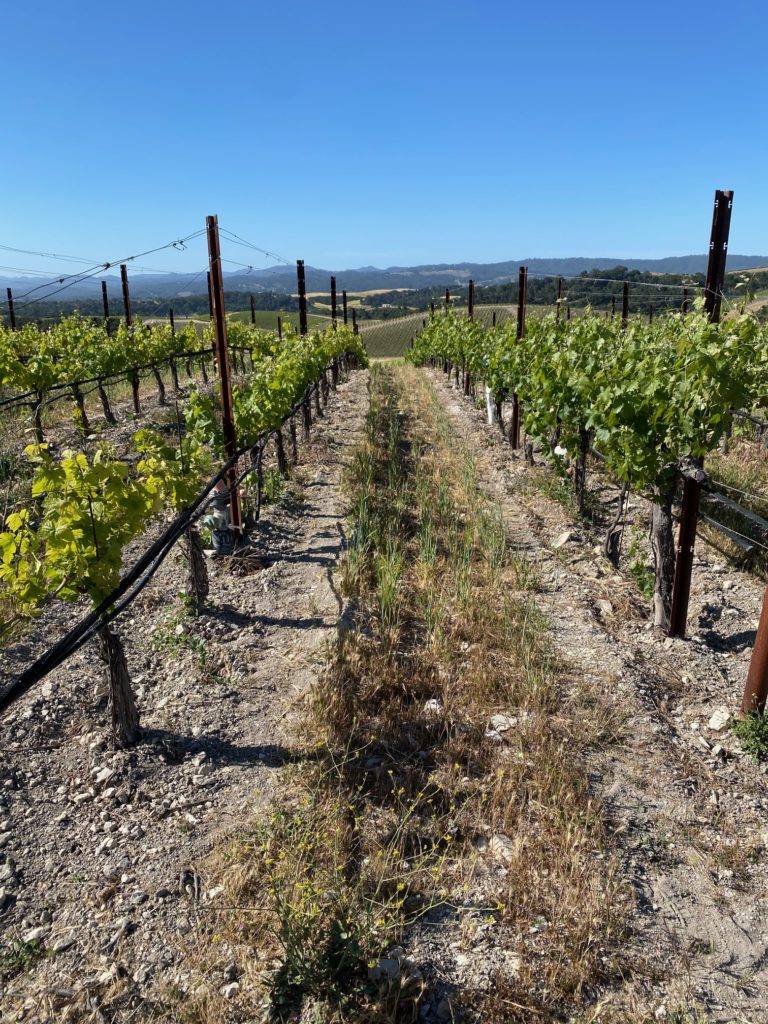When it comes to micronutrients, good things come in small quantities
By Mark Greenspan
The following article first appeared in Wine Business Monthly in June, 2014. Read the original article here.
When it comes to vine nutrition, most of us think about the N-P-K we’re putting out. That makes sense, because each and every year we remove many pounds of these nutrients (mostly N and K) from our vineyards by removing crop and shipping it off-site. Replacement of these macronutrients (N, P, K, Ca, Mg) is usually applied through application of granular fertilizers, liquid fertilizers through the drip system (called fertigation), or sometimes in smaller quantities through foliar applications. Compost additions and cover crops can also supply nutrients to the vineyard. It is essential to provide proper management of macronutrients, which means enough of the proper material, not too much, applied at the right times of the season). I’m not going to discuss that in this column. Rather, I will discuss the small stuff: the micronutrients B, Zn, Mn, Fe, Cu, Mo and S.
You should guess that by virtue of the prefix micro, that the nutrients are needed only in small quantities. That is true, but it does not diminish their importance. While the macronutrients are required as building blocks of cells and important molecules like chlorophyll, micronutrients usually serve roles as cofactors (activators) to enzymatic reactions. Therefore, while their quantities needed are small, they are like keys that open doors to processes that are necessary for growth and development of the vine, its flowers and fruit. I will run through each briefly.
Much of what I am writing comes from personal experience (including a few mistakes), as well as from my favorite reference book, no longer in print (and that was “permanently borrowed” from me many years ago, leaving me only with a scanned copy that I made from another colleague). The book is (was) “Grapevine Nutrition and Fertilization in the San Joaquin Valley”, by Christensen et al., published in 1978. While things have changed to some extent since its publication, especially with foliar fertilization, most of the information is still quite valid. Please do not take any of the following to be recommendations for your specific vineyard. Use of a qualified consultant is essential.

Boron
I’ll start off with Boron, B, because it is the most difficult of the micronutrients to manage, as it has a narrow range between deficiency and toxicity. Therefore, it is not a nutrient to apply routinely without checking of the petiole or blade tissue at bloom time, and possibly again at veraison if you are so inclined.
Boron functions in the differentiation of new cells and plays a role in carbohydrate metabolism. The most common problem with B deficiency is poor fruit set due to poor pollen germination and pollen tube growth. Severe deficiencies will also result in poor shoot growth with small, distorted leaves. This can be a significant problem early in the season, possibly as a carry-over effect of late-season drought that may inhibit B uptake and storage in the vine structure (the “Barnes Effect”).
Besides stunted shoot growth, which can be quite problematic, the primary issue is with fruit set. B deficiency can lead to “shot” berries: seedless berries that remain much smaller than normal berries. The berries tend to be flattened, or pumpkin or tomato shaped instead of the normal round or ovoid shape.
Boron is most commonly applied as a foliar application, along with normal fungicide sprays in the spring. Because poor fruit set is usually the concern, we usually apply the B as a foliar spray in the spring. As with any foliar nutrient application, use of a good adjuvant is essential to allow good uptake of the nutrient by the plant. If it rolls off the leaves, it doesn’t do much good, at least in the short-term. I prefer to split the foliar application into two half-rate applications, with the second one occurring about 2 weeks prior to bloom. That will make sure that levels are adequate to provide a good fruit set, all other factors being adequate. The two most common formulations are Boric acid (often found in 10% liquid formulations) and sodium borate (a.k.a. borax). They are both very effective, though I tend to be fonder of the borax form, as it is a dry material. The one downside to borax is that it contains sodium, though the rates used are very low. Be careful about applying borax to vines during bloom, as the sodium in it can dry up pollen grains and other delicate flower parts. If applied at the correct time (prior to bloom), this should not be a problem. I have seen some phytotoxicity using both formulations, so cannot say that one is better than the other in that respect. Keep the rate low and apply when there is sufficient foliage on the vines – I like about 18” of shoot growth before applying it. We sometimes see the phytotoxicity in cold weather, especially in Pinot Noir, with leaf cupping and reddish flecks around the leaf margins. While we do not want to see that, the vines seem to quickly grow out of it.
Another method for B application is through the herbicide strip spray during winter (if you apply those). I’ve seen longer-lasting improvement in tissue B using this method, though it still often requires some foliar B as an adjunct to the soil-applied material. B may also be applied through the drip system, and vines will take up B readily in this manner.
As I mentioned, application of B must be made cautiously to avoid toxicity. Take tissue samples religiously to determine if levels are increasing and, if so, back off of next year’s application rate. Levels above 35 ppm in bloom petiole tissue indicate adequate levels with 50 ppm being ideal, though anything approaching 100ppm is a signal that B levels are too high and one should curtail B applications until they drop. Furthermore, if soil samples reveal levels of B near or above 1 ppm, that is usually problematic. High boron soils should not be planted in the first place, but fortunately B is most often found to be deficient in soils rather than excessive.

Zinc
Zinc is right up there with boron in its common need for supplementation in the grapevine. Fortunately, it does not have the sensitivity to toxicity that boron does. Its application generally coincides with boron, so we usually find them being applied together. Zinc us used for the formation of the plant hormone auxin, used to direct shoot elongation. It is also used in the formation of chloroplasts, a cell organelle used to conduct photosynthesis. Zinc is needed for leaf development, shoot elongation, pollen development and fruit set. Common deficiency symptoms include stunted shoot growth, featuring shortened internodes, sometimes producing zig-zag shaped shoots. Leaves are misshapen and small, with open petiolar sinuses and chlorotic patterns on the leaves between the small veins. Most common and problematic is poor fruit set, producing scraggly clusters with berries of different sizes. Berries do not appear flattened, as they do in B deficiency.
Zinc application is usually routine, as it is most often deficient in soils and becomes highly unavailable as soil pH rises above 7.0. High levels of soil phosphorus can induce Zinc deficiency, so be cautious about overuse of that nutrient.
Nevertheless, supplementation of Zn in grapevines is easy and can be relatively inexpensive. Foliar applications are common, and I like to split the application into two, the timing just like the one for boron above. There are many materials available for Zn foliar applications. My preference is for zinc sulfate, which is effective and inexpensive. Zinc oxide is less effective and neutral zinc (which contains both sulfate and oxide forms) is less preferable because of the oxide. Chelated zinc can be used as a foliar nutrient, though I have found that the sulfate is just as effective and less costly. On the other hand, soil applications of zinc MUST be made with chelated formulations, so that the zinc remains available and does not become complexed with other soil constituents. Use of other materials is a waste of time and money when applied to soil. Like B, soil applications can be effective and somewhat long-lasting, though not often a complete replacement for the foliar applications in the spring.
Petiole testing at bloom is very useful and levels above 45 ppm and up to 100 ppm usually signify sufficiency. Levels above 100 ppm are not problematic, though they usually point to a lack of need for supplementation for the time being.

Molybdenum
I’m putting molybdenum, Mo, next because it is often applied along with the B and Zn prior to bloom. Mo is not often needed, and it is present in such small quantities in the plant tissue that it is not usually tested. It can be tested, but testing is expensive and usually not worthwhile. Mo is a cofactor in many enzymatic reactions, including those involved with the nitrogen metabolism of the grapevine. It has been found to improve fruit set in Merlot, and I have had dramatic success with it in that regard, though not with scientific verification. It is less certain if Mo improves fruit set in other varieties than Merlot, but I often apply it foliarly to many varieties along with B and Zn prior to bloom if I expect cool weather. It can be applied at very low rates (2 ounces dry weight per acre), so is not terribly expensive. Most commonly, it is obtained as sodium molybdate (40% Mo).
Iron
Iron deficiency is common only to some regions of California – those with calcareous or otherwise high pH soils. High free lime or high phosphorus in the soil will The Central Coast is rife with iron deficiencies and most growers treat their vines annually for iron deficiency. Iron is a cofactor for many enzymatic reactions in the plant, and its deficiency impairs chlorophyll production. Hence the deficiency symptom for iron is a distinct and striking chlorosis, with yellow leaves appearing at the shoot apices. Iron is not mobile in the plant, so while early growth may not show the deficiency, later growth will and this fact makes “iron chlorosis” a very distinguishable symptom in the vineyard. Fe availability drops dramatically above soil pH of 7.0. On the other hand, it becomes highly available at low soil pH levels and we often find very high tissue Fe levels in soils with low pH (low to mid 5’s) here in the north coast. High iron levels are not usually problematic for vines, but we often have issues with iron in irrigation water, where it can lead to clogging of drip emitters.
The central coast deals with perpetual iron deficiency, and if left untreated, it can severely stunt shoot growth and impair fruit development due to the lack of photosynthesis in the plant canopy. Applying iron to the soil is generally fruitless in itself. Acidification of the soil is useful, where acids (usually sulfuric, nitric or phosphoric) are injected essentially continuously into the irrigation water. The acidification temporarily lowers pH of the wetted soil and frees up some iron, but also zinc and phosphorus for the vines. Elemental sulfur has also been used as a soil acidifier, as it oxidizes and releases hydrogen ions from water in the process. The acidification process is very slow and is sped up by using a very finely ground form of sulfur – usually dusting sulfur is best.
Most often, however, foliar iron applications are best. While I work with some growers in the central coast, I am not an expert in dealing with iron chlorosis. However, my clients have experimented with many formulations and do not seem to have a favorite. Sulfates, chelates, lignosulfonates (a type of chelate) all seem to work ok, but not great. The key, I am told, is with repeated applications, essentially applying iron to each and every foliar spray during the canopy development phase. Because it is not mobile in the plant, it needs to be re-applied to all new tissue.

Manganese
Manganese, Mn, is not commonly found to be deficient, but I have seen isolated instances of it, though it is usually simply low levels in petioles and we have not necessarily witnessed deficiency symptoms. It can occur in sandy soils and also in high pH soils. Its function and behavior in the plant are very much like that of iron. Foliar application of Mn are usually the best treatment, as the treatments are at low rates like other micronutrients. We often see high levels of Mn and Fe in petioles in acidic soils. Mn is purported to be toxic at levels around 2000ppm in petiole tissue. However, I have seen some vineyards in excess of that level with no apparent ill effects. There is not much one can do to combat high Mn levels other than to raise soil pH through liming.
Copper, sulfur and yes, sodium
I’m putting these nutrients in the same bucket because they are rarely problematic. I have seen copper at deficient levels and not seen any symptoms to warrant any action. An application of copper sulfate for disease control in early spring is plenty of material to avoid deficiency. Note however, that applications of elemental sulfur (dusting or wettable) are not able to be taken up by the vine. The plant can take up sulfate, which is an oxidized form. However, using foliar nutrients such as zinc sulfate, or fertizers such as potassium sulfate (sulfate of potash) will provide all the sulfur that is needed by the vine, and thus deficiencies are not common at all.
Sodium is a plant nutrient. So are cobalt and nickel, but you won’t see me talking about them because they are never deficient in vines. More commonly, they are at toxic levels. Sodium toxicity is most common and nickel toxicity can also be found in some soils, especially those derived from serpentine.
Micronutrient management is easy, as long as you are careful about boron. Because of that, don’t just spray on a blend of micronutrients and think that you are good to go. I often see growers using proprietary blends of micronutrients and have found them ridiculously low in one or more of the most important ones. I prefer a-la-carte nutrient management in general and it applies very much to micronutrients. Treat them as you need them.

